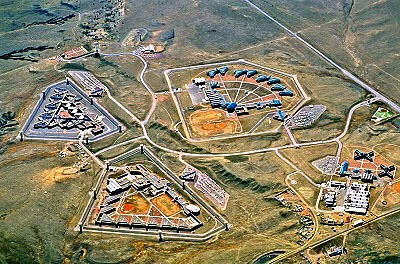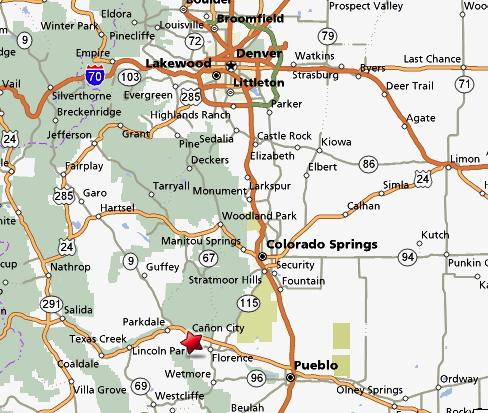<Back to Index>
- Fremont County, Colorado U.S. Penitentiary Administrative Maximum Facility (ADX Florence), 1994
PAGE SPONSOR


The United States Penitentiary Administrative Maximum Facility (ADX) is a supermax prison for men that is located in unincorporated Fremont County, Colorado, United States, south of Florence. It is unofficially known as ADX Florence, Florence ADMAX, Supermax, or The Alcatraz of the Rockies. It is operated by the Federal Bureau of Prisons, a division of the United States Department of Justice. ADX, a part of the Florence Federal Correctional Complex (FCC), houses the prisoners who are deemed the most dangerous and in need of the tightest control of all the prisoners within the United States Federal Prison System.
ADX Florence was constructed as a response to two incidents that occurred on October 22, 1983, in which two inmates murdered their escorting corrections officers at the United States Penitentiary in Marion, Illinois. Relatively lax security procedures allowed an inmate, while walking down a hall, to turn to the side and approach a particular cell so an accomplice could unlock his handcuffs with a stolen key and provide him with a knife. Two officers were killed in two separate incidents by this tactic.
As a response, the prison in Marion went into "permanent lockdown" and transformed itself into a "control unit" prison for the next 23 years. This penal construction and operation theory dictates that inmates remain in solitary confinement for 22 – 23 hours each day. They do not allow communal dining, exercising, or religious services.
Following the killings, Norman Carlson, then director of the Federal Bureau of Prisons, convinced the federal government that a more secure type of prison needed to be designed. There was a need to isolate uncontrollable prisoners from officers and from other prisoners for the sake of security and safety. Marion became a model for the subsequent construction of ADX Florence, a facility built as a control unit prison. Years later, Carlson said that building such a prison was the only way to handle inmates who "show absolutely no concern for human life." He pointed out that the two assailants were already serving multiple life sentences, and simply adding another would have had no effect.
ADX Florence opened in November 1994. The residents in Florence's surrounding area, Fremont County, welcomed the prison as a source of employment in a time of economic hardship. At the time, the county was already home to nine existing prisons. However, the lure of between 750 to 900 permanent jobs, in addition to another 1,000 temporary jobs during the prison's construction, led residents in the area to raise $ 160,000 to purchase 600 acres (242.8 ha) for the new prison. Hundreds of people attended the groundbreaking construction of ADX Florence, which cost over $ 60 million.
On September 14, 2007, the first media tour of the U.S. Bureau of Prison's
Administrative Maximum prison, or "Supermax," was allowed. Attending
reporters remarked on "an astonishing and eerie quiet" within the
prison as well as a sense of safety due to the rigorous security
measures in place within the facility. One person who went on this tour was 60 Minutes producer Henry Schuster,
who said: "A few minutes inside that cell and two hours inside Supermax
were enough to remind me why I left high school a year early. The walls
close in very fast." ADX
Florence is a 37 acre (15 ha), 490 bed complex at 5880 Highway 67,
Florence, Colorado. It is one of three correctional facilities of the
Florence Federal Correctional Complex (FFCC), each with a different
overall security level. The
prison houses several criminals who have been deemed too dangerous or
too high profile for even a maximum security prison, as well as several
terrorists and spies who are too great a national security risk to be
housed in a normal prison. However, 95 percent of the inmates have been
sent to Florence from other prisons due to a history of violent
behavior. These prisoners are kept in solitary confinement for 23 hours a
day for at least the first year. Depending on their records, they can
be let out for longer periods. The long term goal is to transfer them to
a less restrictive prison to serve out the remainder of their terms. ADX Florence generally houses around 430 male prisoners, each assigned to one of six security levels. ADX Florence was designed jointly by DLR Group and LKA Partners of Colorado Springs. Most cells' furniture is made almost entirely out of poured concrete,
including the desk, stool, and bed. Each chamber contains a toilet that
shuts off if plugged, a shower that runs on a timer to prevent
flooding, and a sink missing a potentially dangerous trap. Rooms may also be fitted with polished steel mirrors bolted to the wall, an electric light, a radio, and a television that shows recreational, educational and religious programming. These
are considered privileges that may be taken away as punishment, so they
are placed and remotely controlled such that the inmate does not
actually come into contact with them. The 4 in (10 cm) by
4 ft (1.2 m) windows are designed to prevent the prisoner from
knowing his specific location within the complex because he can see
only the sky and roof through them. Additionally, inmates exercise in
what has been described as an "empty swimming pool," so they do not know
their location for possible escape. Telecommunication with
the outside world is forbidden, and food is hand delivered by
correctional officers. The prison as a whole contains a multitude of motion detectors and cameras, 1,400 remote controlled steel doors, and 12 ft (3.66 m) high razor wire fences. Laser beams, pressure pads, and attack dogs guard the area between the prison walls and razor wire. Eric Rudolph,
the Olympic Park bomber, lamented in a series of 2006 letters to a
Colorado Springs newspaper that the ADX is meant to "inflict misery and
pain." Charles Harrelson,
who was sent to ADX after a failed attempt to escape from a Georgia
prison, said "Part of the plan here is sensory deprivation," and "It
could be infinitely worse." A former ADX warden described the place as "a cleaner version of Hell." There have been hundreds of "involuntary feedings" and four suicides. Most recently, in June 2009 Richard Reid, commonly known as the "shoe bomber", went on a hunger strike and was force - fed. Nonetheless, the prison has come under far less scorn than comparable facilities at the state level. Jamie Fellner of Human Rights Watch said
after a tour of the facility, "The Bureau of Prisons has taken a harsh
punitive model and implemented it as well as anybody I know."